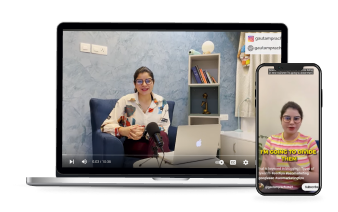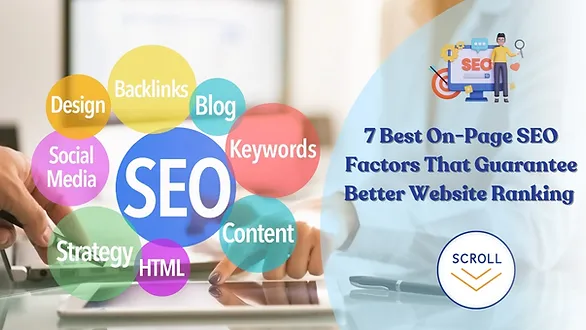

Do you also find it difficult to rank your website on the first page of the search engine? Or, are you struggling to discover the best on-page SEO factors that you can use to rank your website on the first page of the SERPs? Well, you are not alone.
If you want to improve the visibility of your website, increase traffic, and scale up your business, you can make use of effective on-page SEO factors to fulfill your desired actions.
This includes the use of high-volume keywords, precise placement of the keywords in the website content, title tag optimization, meta description optimization, image optimization, and so on. But first, let us understand the importance of On-Page SEO factors for your website.
On-page SEO factors involve optimizing your website by carrying out various techniques that lead to your website ranking better on the search engine. On-page SEO helps you drive organic traffic to your website. This, in turn, gives you more conversions and revenue for your business.
A search engine will always admire a website that relates to a user’s search intent and provides them with the desired results. And if your website fulfills what the user is looking for, it will rank higher in the search results.
Hence, on-page SEO factors can be your secret sauce for getting organic traffic and giving a sales boost to your business. So, what are you waiting for? Let’s take a deep dive to learn about the 7 best on-page SEO factors that guarantee better website ranking.
“Great content inspires action.”
- Dane Brookes
One of the significant on-page SEO factors is to write unique, engaging, and relevant content for your website. It drives the audience to read your content related to your pursuit. You should use relevant keywords and topics for your content that the audience is seeking information about.
Use the guidelines below, linked with on-page SEO factors, to write high-quality content for your website.
Keywords describe the type of content on your website. But, from the perspective of on-page SEO factors, they help your website rank on the first page of the SERP. Hence, there are some things that you can consider while doing keyword research for your website.
Some of the best tools you can use for your website’s keyword research are:
Have you ever thought that you are placing keywords in a manner that will improve your website’s ranking? This is one of the major on-page SEO factors that you must not overlook.
Optimize your content by placing keywords in a strategic format. On-page SEO factors give you the most important areas of your website’s content in which you can place your keywords.
Some of them are:
These on-page SEO factors can help the search engine index your website and identify it according to the keywords you are targeting.
How does grammar play an important role in optimizing your content? Does spelling mistakes in your content affect your website’s ranking?
If your website content has grammatical errors, it will be difficult for the audience to read and process the information. Hence, you must make sure that the content you are writing for your website is unique and has no spelling errors.
On-page SEO factors support some of the best tools online to check your content’s grammar and uniqueness.
Heading tags (H1, H2, and H3) as a part of on-page SEO factors improve the readability of your content. It can make your website rank higher on search engines, as it is easier for the audience to read and understand your content. To optimize the heading tags, insert the primary focus keyword into them.
If you want the audience to click on your website, you have to write titles for your pages that entice them. Therefore, on-page SEO factors also include optimizing title tags, which are essential for increasing your website’s CTR (click-through rate).
How can you optimize your title tags?
Example: Buy resin jewellery online at 40% off, valid for 3 days.
One of the best on-page SEO factors, the meta description gives your audience a gist of what your website page is about. On-page SEO factors involve optimizing your meta description in such a way that it catches the attention of your audience, increases traffic, and improves the website’s ranking.
Optimize your meta descriptions using the following methods:
“A picture is worth a thousand words.” Whenever we type anything on Google, we see different images. All the images have a different ranking depending on which page they appear on. Optimized images encourage user engagement and experience on the website.
Well, you must be wondering how I can optimize images according to on-page SEO factors. Don’t worry! Here is your go-to guide.
Through this blog, now that you have realized how important it is to use these 7 best on-page SEO factors for your website, let’s not waste any time and soak our minds to implement these on-page SEO factors, boost our online presence, and rank our website on the first page of the search engine.
On-page SEO factors are the need of the moment for you to attain a high ranking on the SERPs, giving a touch of uniqueness to your website, increasing your website’s CTR, gaining a high level of traffic, optimizing conversion rates, leveraging sales, and what not!
If you want to know more about on-page SEO factors and how to take your online presence to the next level, what are you waiting for? Click here to enroll now to learn about the “Complete SEO Guide From Beginner To Advanced Level.”
About the author: Anshika Wahal is a working professional from Noida, Uttar Pradesh, who has a keen interest in content writing and SEO-friendly blogging. Having a diverse experience in commercial content writing, she has written content in different niches like fashion, lifestyle, travel, health, hospitality, digital marketing, e-commerce, and many more.
Contact here:
Email ID- [email protected]
LinkedIn ID- https://www.linkedin.com/in/anshika-wahal-62756317b/
Happy blogging!

A small-town lady, blogger, educator and puppy rescuer. My utmost days are spent behind my mac screen sharing my life and secret sauce with the world. And now, I'm ready to guide you starting your side-gig!
One thought on “7 Best On-Page SEO Factors That Guarantee Better Website Ranking”
Amazing and very helpful ! Thanks for writing and publishing this blog. 😃